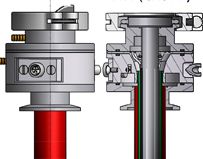Cryogenic attend many events throughout the year all over the World
Cooling MRI magnets without a continuous supply of scarce helium
Cryogenic has developed a new way to cool magnets for MRI machines to near absolute zero without the need for a continuous supply of liquid helium.
MRI (magnetic resonant imaging) machines work by generating a very large magnetic field using a super conducting magnet and many coils of wires through which a current is passed. Maintaining a large magnetic field needs a lot of energy, and this is accomplished using superconductivity, which involves trying to reduce the resistance in the wires to almost zero. This is done by bathing the wires in a continuous supply of liquid helium at -269.1C. A typical MRI scanner uses 1,700 litres of liquid helium, which needs to be topped up periodically.
The problem is that helium is running out, as explained by chemist Peter Wothers in the Royal Institution's 2012 Christmas Lectures. Despite being the second most abundant material in the universe, helium is scarce on Earth as its lightness means it is not gravitationally bound to the atmosphere and is therefore constantly being lost to space. The majority of the world's helium supply is created through natural radioactive decay and cannot be artificially synthesised, meaning the gas is a non-renewable resource.
Cryogenic has developed a technique to cool magnets to close to absolute zero without needing liquid helium, only a small fixed amount of helium (equivalent of maybe half a liquid litre). The company is offering its magnets for use in a variety of imaging techniques including MRI, Nuclear Magnetic Resonance spectroscopy and Electron Spin Resonance spectroscopy.
The magnets can be cooled to low temperatures using mechanical refrigerators which run using electrical power and cooling water. The coolers rely on the compression and expansion of a fixed volume of helium gas supplied under pressure in a closed, self-contained circuit -- much like how an airconditioning unit would work. The helium gas remains cold and doesn't condense into a liquid.
Cryogenic's "dry" system eliminates the need for skilled manpower to transfer and handle the liquid helium. Director Jeremy Good explains to Wired.co.uk: "It's much like if you were trying to cool some drinks. Do you get a sack of ice cubes or a refrigerator?"
Cryogenic says that its system avoids a problem that sometimes occurs with MRI machines, called "quenching". This is when the wire in the electromagnet stops being superconducting and starts to generate a lot of heat. At this point, any liquid helium around the magnet rapidly boils off and escapes from the vessel housing the magnet. For this reason places using liquid helium need special ventilation facilities.
The managing director of Cyrogenic Jeremy Good, said in a statement: "In recent years major research laboratories have had to temporarily shut down multimillion-pound facilities because of these [helium] shortages and the problem will only get worse. Providing an alternative which doesn't rely on a regular supply of helium is essential to addressing this problem."
Cryogenic mainly focuses on MRI and other instruments based in research facilities, and doesn't currently make a cooling system for the full-body MRI machines that exist in hospitals. Good says that there are no fundamental reasons why Cryogenic's technology could not be used in this context and that he is in conversations with major manufacturers of those systems.
Sources:
http://www.wired.co.uk/news/archive/2013-08/12/mri-magnet-cooling
http://www.med-techinnovation.com/News/home/news/950
http://www.themanufacturer.com/articles/liquid-helium-free-mri-machines-...





